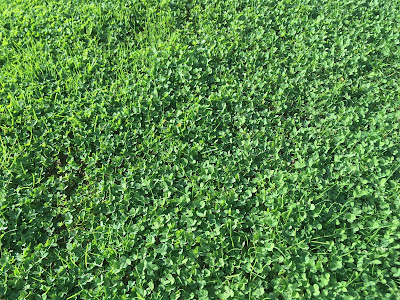After World War II, Americans embraced what a team of environmental scientists at Yale has termed the Industrial Lawn, defined as closely mowed, continuously green, and ideally free of weeds and pests. The Industrial Lawn requires regular inputs of water, fertilizer, pesticides, and herbicides. Energy costs are high, not just for mowing but also for synthesizing and transporting the chemicals used.
 |
| Industrial Lawn: turf grass only |
Why did we Americans embrace this Industrial Lawn, and why right after World War II? One reason was the development of an herbicide, 2,4-D, for use by the military (If this name sounds familiar, it might be because of Agent Orange, which contained both 2,4-D and 2,4,5-T, another phenoxy herbicide). During the war, chemists in England and the US raced to develop an herbicide that could wipe out German potato crops and Japanese rice, to starve out the enemy.
 |
| Spraying herbicide over Vietnam |
To their disappointment, potato and rice plants turned out to be resistant to 2,4-D. It did kill broadleaf plants in turf, though, without killing the grass. The Scotts company realized this could be a goldmine. In 1947, Scotts started selling 2,4-D in their Weed and Feed combination—herbicide plus fertilizer. Scotts had just one problem. Their new weedkiller killed clover.
Before the war, grass seed mixes included clover seed. White or Dutch clover originated in southeastern Europe and Asia minor. It’s spread all over the world because it works so well for pastures—and lawns. I like to use clover to fill in bare patches in my lawn. Rabbits love it, and I think it’s keeping them from wiping out my perennials.
 |
| Rabbits like clover-photo ibm4381 |
Clover is a legume that fixes nitrogen in the soil, in effect making lawn fertilizer. It stays green all summer; it’s easy to grow, drought tolerant, and pest free. It aerates the soil. It stays low. Dog urine doesn’t cause it to discolor; and it attracts bees and beneficial wasps that control leaf-eating insects. It sounds like an asset for any lawn, right? Before the war, that’s how it was marketed.
 |
| To me, clover looks good in a lawn |
But because of 2,4-D, Scotts changed their marketing approach. They told consumers that clover was a weed. That idea persists up to the present time; lawn care contractors still cringe at the sight of clover in the lawn.
 |
| Making killing clover a selling point |
Although we like to think that advertising doesn’t affect us, this kind of messaging has an impact. Don’t be fooled. I’m trying to grow less lawn and convert the space to more environmentally friendly uses. No matter how much lawn you like to maintain, though, don’t let anyone convince you that clover shouldn’t be part of it.












